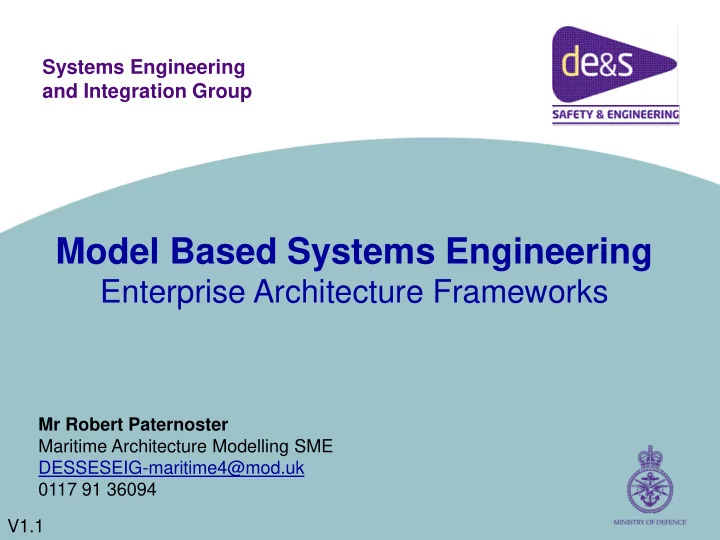

Systems Engineering and Integration Group Model Based Systems Engineering Enterprise Architecture Frameworks Mr Robert Paternoster Maritime Architecture Modelling SME DESSESEIG-maritime4@mod.uk 0117 91 36094 V1.1
Aim • To understand the benefits of Enterprise Architecture (EA) modelling • To become familiar with the principle and structure of MODAF
Definition of Enterprise • An "enterprise" is any organisation or collection of organisations, that have a common set of business goals and/or a single bottom line. TOGAF Definition
Definition of Architecture • Architecture is about structure and inter-relationship • Some uses of the term architecture: – A Computer Architecture describes the structure and organization of a computer's hardware or system software – Architecture is the art and science of designing and constructing buildings – A Web Services Architecture identifies the functional components and defines the relationships among those components to effect the desired properties of the overall architecture
Definition of Enterprise Architecture • “The formal description of the structure and function of the components of an enterprise, their interrelationships, and the principles and guidelines governing their design and evolution over time” (Ref: IEEE 1471).
Components of an Enterprise • An enterprise is made up of many components including but not limited to: – People – Processes – Physical Structures – Engineering and Information Systems – Financial Resources • In order to achieve the common “Enterprise Goal” these components must coordinate their functions and effectively exchange information and resources • For large enterprises, these relationships between components can be very complex.
Managing Complexity • This complexity tends to lead to the creation of stove-pipes where different areas of an enterprise operate in isolation. • This lack of “bigger picture approach” can result in: – Reduced Efficiency – Poor Investment Decisions – Duplication of Effort – Loss of agility • One way of managing this complexity and preventing the creation of stove-pipes is to model the enterprise architecture
Modelling the Enterprise Architecture • Enterprise Architecture (EA) models enable the capture and presentation of information relating to the Enterprise, with the aim of: – Aiding the understanding of complex issues – Gaining a consistent understanding of the EA and associated assumptions thus avoiding expensive rectification projects – Supporting Enterprise planning and change management activities – Analysing the model to identify and articulate potential issues – Supporting the elicitation of a coherent set of requirements • Architecture models are developed at a level of detail that is appropriate for a given objective.
A Common Framework • Large corporations may well have separate enterprise architecture projects – But there is much in common about the systems in each “enterprise” – There is usually great potential for gain in the use of a common architecture modelling standard or framework • A common framework can provide a basis for the development of an architecture repository: – Allows the integration and re-use of models, designs, and baseline data
What is MODAF? • Ministry of Defence Architecture Framework • An Enterprise Architecture Framework (or “standard”) designed specifically for the MoD Enterprise – A set of rules and constraints on how to organise information about the enterprise – Templates that provide a graphical and textual visualisation of the enterprise area being investigated – Guidelines to govern architecture activity • MODAF provides a language or “grammar” to produce consistent and coherent enterprise architectures across Defence
MODAF Views • A MODAF view describes a specific aspect of an enterprise architecture • For example: – Strategic View (StV) 1 – Enterprise Vision. Designed for senior management to capture the strategic direction of the enterprise – System View (SV) 2a - System Port Specification. Designed for engineers to specify the ports on a system, and the associated protocols used. • Within MODAF 1.2 there are 46 different MODAF views
MODAF is NOT… A lot of disconnected views
Why MODAF is NOT a lot of disconnected views? OV-1a : High-Level Operational Concept Graphic • Underlying Model Constructed in Accordance to MODAF Meta-Model
Why MODAF is NOT a lot of disconnected views? OV-1a : High-Level Operational Concept Graphic Underlying Model Constructed in Accordance to MODAF Meta-Model
MODAF Viewpoints All View Strategic (AV 1-2) (StV 1-6) Why? ‘Summary’ ‘Capabilities’ Technical (TV 1-2) ‘Constraints’ Service Operational Orientated (OV 1-7) (SOV 1-5) What? ‘Services Available’ ‘Logical’ Acquisition (AcV 1-2) System When? (SV 1-12) ‘Programmatic’ How? ‘Solution’
Simplified MODAF 1.1 Meta-Model (M3)
Simplified MODAF 1.1 Meta-Model (M3) StV5 AcV2 StV1 SV2a StV2 SV1 TV1 OV2
Views Example: Joint Fires OV1 StV2 Strategic JF Operational OV5 OV3 OV3 Locate ID Decide Destroy (Info Ex) (Info Ex) (Surveillance) (C&C) (Effect) System Acquisition AV1 STV2 OV1 OV2 OV3 OV5 SV1 SOV2 Acv2 TV1
Views Example: Joint Fires OV1 StV2 Strategic JF Operational OV2 OV3 OV3 (Info Ex) (Info Ex) (Surveillance) (C&C) (Effect) System Acquisition AV1 STV2 OV1 OV2 OV3 OV5 SV1 SOV2 Acv2 TV1
Views Example: Joint Fires OV1 StV2 Strategic JF Operational SOV2 SOV2 Locate ID Decide Destroy (Surveillance) (C&C) (Effect) System Acquisition AV1 STV2 OV1 OV2 OV3 OV5 SV1 SOV2 Acv2 TV1
Views Example: Joint Fires OV1 StV2 Strategic JF Operational SOV2 SOV2 Locate ID Decide Destroy (Surveillance) (C&C) (Effect) SV1 System (Cap Config) (Cap Config) (Cap Config) (Cap Config) Acquisition AcV AcV2 AcV2 2 AcV 2 200 202 0 8 2008 2020 2008 2020 2008 2020 AV1 STV2 OV1 OV2 OV3 OV5 SV1 SOV2 Acv2 TV1
Summary • MODAF is an Enterprise Architecture Framework designed specifically for the MOD enterprise • The MODAF Meta-Model (M3) enables enterprise architecture modelling to be done consistently across Defence • The 46 MODAF views provide a common way of presenting outputs from the MODAF compliant models • MODAF is an evolution of DoDAF and basis for NAF revision 3
Questions?
Recommend
More recommend